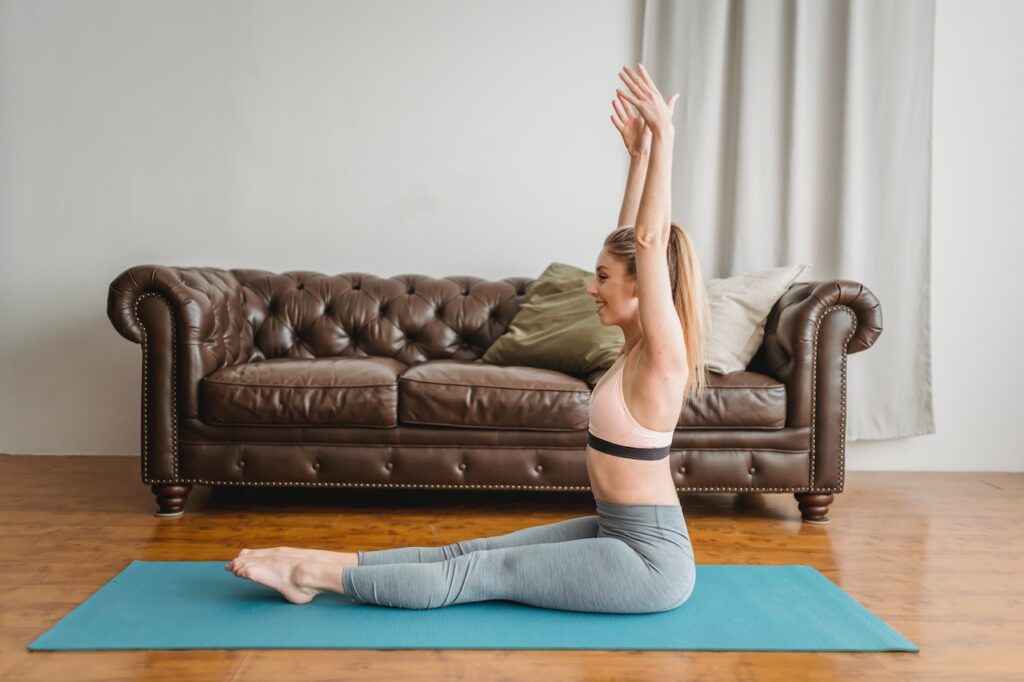Dandasana is a basic seated asana that is often used as a starting point for many seated yoga postures.
The word “Dandasana” comes from the Sanskrit words “Danda” which means “Staff” or “Stick” and “Asana,” which means “Posture”. Hence the term Staff Pose in English.
The “Danda” in the pose symbolizes our strong erect spine while holding the pose.
By the looks of it, this seated asana is as simple as sitting down on your mat with your spine straight and legs stretched out in front of you. Easy, right?
Well, chances are that you would probably change your opinion if you try holding the pose in the correct posture for some time.
Dandasana to seated postures is what Tadasana is to Standing postures. It is the very foundational seating pose from which all other poses begin and also can be used as transitional pose between seating postures. It helps to bring awareness to how we hold our body and helps in improving our posture.
How to do Dandasana?
- Sit on the floor with your legs extended in front of you, your feet together.
- Flex your feet by stretching your toes towards your body. This stretches your calves and hamstrings. Your heels should be grounded on your mat.
- Place your hands on the floor beside your hips with your fingers pointing forward.
- Press your sitting bones into the floor, and engage your leg muscles to lift your kneecaps.
- Inhale and press down the palms of your hands to lengthen your spine.
- Keep your neck straight and gaze straight ahead.
- Roll your shoulder back and down and expand your chest
- Draw your lower belly in towards your spine to engage your core muscles and support your lower back.
- Deeply inhale and exhale while holding the pose. Hold the pose for as long as comfortable.
Benefits of Dandasana
- Improves posture
- Strengthens back, core, and leg muscles
- Stretches the hamstrings and calves
- Increases awareness of the body
- Prepares the body for seated yoga postures
Contraindications of Dandasana
Dandasana is generally safe for most people, but it should be avoided if you have any recent injuries to your wrists, lower back, or hips. Wait till you are fully recovered.
Variations of Dandasana
- One-legged Dandasana: From Dandasana, inhale and lift one leg off the ground. Hold this pose for a few deep breaths. Exhale and bring the leg down with control. Repeat with the other leg. This further strengthens the core and leg muscles.
- Dandasana with arms overhead: Raise and extend your arms up overhead instead of placing them beside your hips to add to the challenge
- Seated forward fold (Paschimottanasana): Dandasana can be a starting position for Paschimottasana. Bend forward from the hips keeping your back straight and reach for your feet to deepen the stretch in the hamstrings.
Modifications of Dandasana
- You can keep your palms, facing forward, slightly behind your hips for an easier version
- If you find it difficult to straighten your back sit on props such as blocks, bolsters, or blankets to elevate your hips.
- You can also practice Dandasana with your back against a wall
- If you feel too much strain on your hamstrings, you can keep a slight bend in your knee. As you build your hamstring flexibility, you will be able to straighten the knee without much strain.
- If you find it difficult to keep your legs together, you can keep them hip-width apart.
Common Mistakes or Misalignments:
- Sagging in the lower back – Pull your lower abdomen to your spine and press down your palms to engage your lower back. If it’s difficult, sit on a block or blanket to elevate your hips.
- Rounded shoulders – Pull your shoulders back and down, away from your ears
- Legs not engaged – Flex your feet and lift your kneecaps up to engage leg muscles
- Overarching you back – The idea is to maintain a neutral spine. Think of lengthening the spine by reaching up through the crown of your head.

